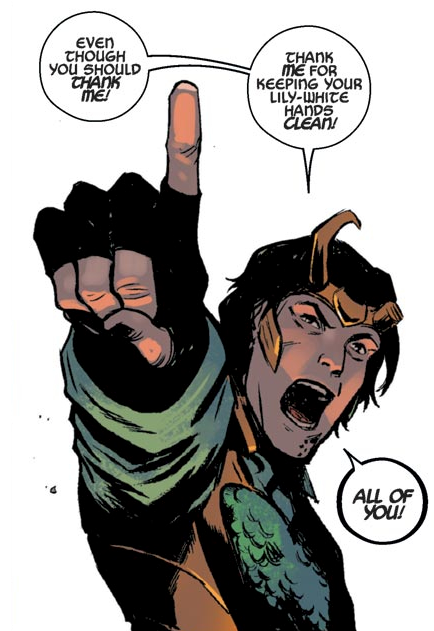
I mentioned last time the fun I had with the concept of the TVA — what it does, what it’s named, and how that works for it in a serial streaming show. Episode two of Loki, titled “The Variant,” really plays with that.
Last episode ended on the series pitch: There’s another variant Loki, and they need our Loki to catch him. When we start this one, we see that in play: TVA agents arrive at a Renaissance faire in Oshkosh, Wisconsin, in the year 1985, and they’re summarily dispatched in a dark tent by a hooded trickster using green magical flares and knives. Our Loki’s first field mission is to the site of this altercation, but it’s not much of a mission this time around, as he uses it to test his boundaries.
As audiences, we’ve seen Loki try this kind of trick before, and it’s important for the development of Hiddleston’s character that he does so again, only to have it fail. That way, we’re gifted twofold: First, we know that the TVA is more competent than bureaucrats are traditionally depicted, and second, we know that the old tricks aren’t going to be enough. It reinforces the idea of the character as one who is constantly trying to escape his old habits, only to fall back into them because the opportunities that arise are just so tempting. Have we seen it before? Sure, but that’s part of the fun of it; it’s almost a metafictional story itself, watching this god of mischief try and try again, ever hounded by his own domain.
The usage of the hood in the opening scene, the way it completely drapes and obscures the antagonist’s face, is an old storytelling trick, and the kind of thing that I just love seeing. Last time, it was used in Avengers: Infinity War for the dramatic reveal of the penitent Red Skull, overseeing the site of the Soul Stone on the planet Vormir. That one lacked a little punch, because, well, a penitent Nazi is still a Nazi, but I make the comparison because the reveal at the end of this episode of Loki executes the same trick with much more success.
There’s been buzz about the idea of this series being the god of mischief’s dip into the Doctor Who pond, and with the time-hopping, adventure-heavy vibe of the first two episodes, it’s easy to make that comparison. I personally find the TVA to be a little more on par with The Umbrella Academy’s Commission, but it’s not hard to argue that those different stories all hang out in the same general space, stylistically.
There is one thing that struck me as a very nod-and-wink sort of reference to the famous time-traveling Doctor, though. When the variant Loki drops her hood in the flickering light of a Roxxcart department store, we’re treated instead to the blonde, bob-cut visage of Sophia Di Martino. It’s a fun reveal on the heels of last week’s discussion of Loki’s gender-fluid status (even if it doesn’t quite live up to that descriptor), but the real impact for me was the way Di Martino looks like a dark ringer for the Doctor’s current incarnation, played by Jodie Whittaker.
Sure, the garb is different, but the unkempt haircut is generally the same length and color. Whittaker’s ascension as the Doctor was a media firestorm at the time it happened, as a historically male role was taken by a woman for the first time. We see that mirror here, as well; Di Martino is playing a different incarnation of Loki, wearing Loki’s signature crown (though damaged, with one broken horn). But thematically, Loki and the Doctor aren’t terribly different as characters, a fact that becomes apparent once you drop the trickster god into a continuity-focused story. The Doctor, after all, is a rogue who answers to no one but the demands of conscience, often undertaking risky, convoluted plans to achieve personal goals. Loki is much the same; it’s just that his goals are generally more selfish, a thing he’s struggled with multiple times in various (or, I suppose, variant) incarnations in the MCU.
That’s something that also comes from comics, and the broken left horn in particular is a thing we’ve seen before in another version of Loki with a penchant for occupying other people’s bodies. In the 2014 series Loki: Agent of Asgard, a newer, younger version of Loki sets off to erase his prior version’s crimes for the sake of Asgard. Along the way, he struggles not only with the history of actions under his name, but his very nature as a trickster god and a capital-V Villain, destined to ever play the foil to his heroic brother, Thor.
It’s a really neat idea, to pit these two Lokis against each other, but of course, as I was thinking about it, yet another reference occurred to me. One of the points set up in this episode was that there have been many (many) Loki variants that the TVA has hunted down over the … years? Sure, we’ll go with years. Each of those variants, while essentially remaining Loki, has had different specialties and powers; there was, hilariously, a brief depiction of a large, shirtless, muscular version, for instance. Our Loki specializes in a kind of duplication magic, as he waxes on about during the episode, but the Di Martino Loki they’re chasing uses enchantment magic. It’s not much on its own — enchantment is certainly in Loki’s bag of tricks, as seen with Hawkeye in 2012’s Avengers, even if it’s not his primary tactic. However, once Di Martino removed that hood, I remembered that there is another Asgardian who specializes in enchantment magic. She’s blonde, fond of green, and she goes by the name of Amora, the … well, the Enchantress.
I’ve talked before about the approach these Disney+ series take to adapting Marvel’s source material being an intriguing one, and that holds here; the idea of a female Loki antagonist who is also a play on the Enchantress and also a sly wink at the Thirteenth Doctor is a fun one. It’s also, potentially, a much more interesting direction for the character of the Enchantress, should that turn out to be who Di Martino’s playing here. The Enchantress’s comic counterpart is one of those concepts that does not hold up well under scrutiny; a vain and petty character, she’s sent not to plague Thor, but to eliminate his love interest, Jane Foster. Naturally, comics in the 1960s being what they were, the Enchantress cannot help but have her own romantic designs for Thor, a recurring plot element that caused her to endlessly scheme in order to win his affections. Early Thor comics were full of these sorts of depictions of women — hardened battle-maiden Sif was also in love with Thor, as was Valkyrie at one point.
So is this version of Loki actually the Enchantress? It’s hard to say. Sometimes these things are just visual references; sometimes they’re the real deal! Either way, Di Martino imbues the character with a sense of purpose and capability, as do the various other actors playing the role while Loki briefly inhabits their bodies. This is not a character with designs so banal as tricking a man into loving her — as she says in the episode, she’s got shit to do.



